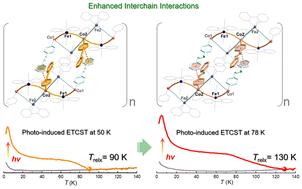当前位置:
X-MOL 学术
›
Inorg. Chem. Front.
›
论文详情
Our official English website, www.x-mol.net, welcomes your
feedback! (Note: you will need to create a separate account there.)
Interchain interactions raised the photo-induced [LS] → [HS*] transition temperature to 78 K in a cyanide-bridged [FeIII2CoII] chain
Inorganic Chemistry Frontiers ( IF 6.1 ) Pub Date : 2024-11-20 , DOI: 10.1039/d4qi02428a Wen-Jing Jiang, Yin-Shan Meng, Han-Han Lu, Hai-Lang Zhu, Qiang Liu, Chunying Duan, Hiroki Oshio, Tao Liu
Inorganic Chemistry Frontiers ( IF 6.1 ) Pub Date : 2024-11-20 , DOI: 10.1039/d4qi02428a Wen-Jing Jiang, Yin-Shan Meng, Han-Han Lu, Hai-Lang Zhu, Qiang Liu, Chunying Duan, Hiroki Oshio, Tao Liu

|
Bistable mixed valence compounds have thermodynamically accessible phases at certain temperatures, and the electron transfer switches the electronic configurations by applying external stimuli like heat and light. Thermally induced phase transition temperatures range widely, while the photo-induced state conversions need irradiation at very low temperatures, such as below 30 K, and the photo-induced metastable state relaxes rapidly at low temperatures. We prepared new mixed-valence compounds of [Fe(bipy)(CN)4]2[CoL2] (L = 4-[(1E)-2-phenyldiazenyl]pyridine for 1-papy and 4-(2-phenylethynyl)pyridine for 1-pepy) in which cyanide-bridged squared cores form corner-shared chains with substantial interchain π–π contacts. Mössbauser spectra revealed that 1-papy and 1-pepy are in the high-spin (HS) state [(FeIIILS)2CoIIHS] at 300 K and the low-spin (LS) state [FeIILSFeIIILSCoIIILS] at 78 K, confirming the occurrence of the electron transfer coupled spin transition (ETCST). Magnetic susceptibility measurements suggested their Tc values of 231 and 260 K, respectively. Photoirradiation (808 nm) for 1-papy and 1-pepy at 10 K induced the state conversion from the [LS] to the [HS*] state, and the metastable [HS]* state relaxed to the thermodynamically stable [LS] states at temperatures (Trelax) of 130 and 90 K, respectively. Furthermore, the [LS] states in 1-papy and 1-pepy were fully converted to the [HS*] states by light irradiation at 78 and 50 K, respectively. The X-ray structural analyses showed characteristic coordination bond lengths for the metal ions in each electronic state before and after light irradiation, but shortened intrachain πL⋯πL contact distances, from 3.726(4) to 3.688(4) Å, were observed for 1-papy upon the state conversion from the [LS] to the [HS*] state, despite the swollen cell volumes from 2479 to 2566 Å3, respectively. Photomagneto and structural studies suggest that the intermolecular interactions increase the light-induced state conversion and relaxation temperatures.
中文翻译:

链间相互作用将氰化物桥 [FeIII2CoII] 链中光诱导 [LS] → [HS*] 转变温度提高到 78 K
双稳态混合价化合物在一定温度下具有热力学可及相,电子转移通过施加外部刺激(如热和光)来切换电子构型。热诱导相变温度范围很广,而光诱导态转换需要在非常低的温度下(例如低于 30 K)进行照射,而光诱导亚稳态在低温下会迅速松弛。我们制备了 [Fe(bipy)(CN)4]2[CoL2] (L = 4-[(1E)-2-phenyldiazenyl]pyridine 用于 1-papy,4-(2-苯基炔尼基)pyridine 用于 1-pepy)的新型混合价化合物,其中氰化物桥式方形核心形成具有大量链间 π-π 接触的角共享链。Mössbauser 光谱显示,1-papy 和 1-pepy 在 300 K 时处于高自旋 (HS) 状态 [(FeIIILS)2CoIIHS] 和低自旋 (LS) 状态 [FeIILSFeIIILSCoIIILS] 在 78 K 时,确认了电子转移耦合自旋跃迁 (ETCST) 的发生。磁化率测量表明它们的 Tc 值分别为 231 和 260 K。 在 10 K 下,1-papy 和 1-pepy 的光辐照 (808 nm) 诱导了从 [LS] 状态到 [HS*] 状态的转换,并且在 130 K 和 90 K 的温度 (T弛豫) 下,亚稳态 [HS]* 状态分别松弛到热力学稳定的 [LS] 状态。此外,1-papy 和 1-pepy 中的 [LS] 态分别通过 78 和 50 K 的光照射完全转换为 [HS*] 态。X 射线结构分析显示,光照射前后每种电子状态下的金属离子具有特征配位键长,但在从 [LS] 状态转换为 [HS*] 状态时,观察到 1-papy 的π π链内接触距离缩短,从 3.726(4) 到 3.688(4) Å,从 2479 Å 膨胀到 2566 Å3分别。光磁子和结构研究表明,分子间相互作用增加了光诱导的状态转换和弛豫温度。
更新日期:2024-11-20
中文翻译:

链间相互作用将氰化物桥 [FeIII2CoII] 链中光诱导 [LS] → [HS*] 转变温度提高到 78 K
双稳态混合价化合物在一定温度下具有热力学可及相,电子转移通过施加外部刺激(如热和光)来切换电子构型。热诱导相变温度范围很广,而光诱导态转换需要在非常低的温度下(例如低于 30 K)进行照射,而光诱导亚稳态在低温下会迅速松弛。我们制备了 [Fe(bipy)(CN)4]2[CoL2] (L = 4-[(1E)-2-phenyldiazenyl]pyridine 用于 1-papy,4-(2-苯基炔尼基)pyridine 用于 1-pepy)的新型混合价化合物,其中氰化物桥式方形核心形成具有大量链间 π-π 接触的角共享链。Mössbauser 光谱显示,1-papy 和 1-pepy 在 300 K 时处于高自旋 (HS) 状态 [(FeIIILS)2CoIIHS] 和低自旋 (LS) 状态 [FeIILSFeIIILSCoIIILS] 在 78 K 时,确认了电子转移耦合自旋跃迁 (ETCST) 的发生。磁化率测量表明它们的 Tc 值分别为 231 和 260 K。 在 10 K 下,1-papy 和 1-pepy 的光辐照 (808 nm) 诱导了从 [LS] 状态到 [HS*] 状态的转换,并且在 130 K 和 90 K 的温度 (T弛豫) 下,亚稳态 [HS]* 状态分别松弛到热力学稳定的 [LS] 状态。此外,1-papy 和 1-pepy 中的 [LS] 态分别通过 78 和 50 K 的光照射完全转换为 [HS*] 态。X 射线结构分析显示,光照射前后每种电子状态下的金属离子具有特征配位键长,但在从 [LS] 状态转换为 [HS*] 状态时,观察到 1-papy 的π π链内接触距离缩短,从 3.726(4) 到 3.688(4) Å,从 2479 Å 膨胀到 2566 Å3分别。光磁子和结构研究表明,分子间相互作用增加了光诱导的状态转换和弛豫温度。






























 京公网安备 11010802027423号
京公网安备 11010802027423号